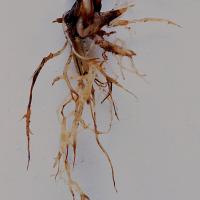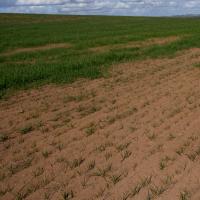Diagnosing rhizoctonia root rot in cereals
A widespread root disease caused by a soil-borne fungus and generating yield losses of 1-5% in Western Australia each year.
What to look for
- Severely stunted plants occur in patches with a distinct edge between diseased and healthy plants.
- Patches vary in size from less than half a metre to several metres in diameter.
- Patches of uneven growth occur from mid winter when seminal roots have established.
Paddock
- Affected plants are stunted with stiff, rolled leaves and are sometimes darker green than healthy plants.
- Roots of affected plants are short with characteristic pinched ends: ‘spear tips’.
Plant
What else could it be
| Condition | Similarities | Differences |
|---|---|---|
| Diagnosing pythium root rot in cereals | Patches of stunted plants with stubby and dead roots | Rhizoctonia has spear-tip roots and occurs in distinct patches |
| Diagnosing root lesion nematode in cereals | Patches of stunted plants with brownish roots | Root lesion nematode has 'spaghetti' roots and patches are less distinct with more variation in plant growth |
| Diagnosing Desiantha weevil in cereals | Poor plants with spear tip roots in patches | Desiantha weevil damage is seen at tillering on surviving plants, in amongst dead ones. Small weevils with yellow heads occur near roots |
Where did it come from?
- It is difficult to control because it can survive in the soil without a live host.
- Often associated with minimum tillage systems, low soil fertility and poor plant nutrition.
Management strategies

Cultivation

Seed dressing fungicide
- Deep cultivation before seeding can reduce the impact of rhizoctonoia root rot.
- Cultivation 10 centimetres (cm) below the seed using knife-points at seeding can reduce the impact of rhizoctonoia root rot.
- Levels of rhizoctonia in the soil will be highest after cereals, especially barley and lowest after canola.
- Use a seed-dressing fungicide registered for Rhizoctonia suppression; these do not eliminate the patches.
- Adequate fertility at seeding and tillering, especially N and Zn; N placed below seed.
- Significant summer rainfall after harvest with good weed control can reduce rhizoctonia levels in the soil.
See also
Further information
Where to go for expert help
Page last updated: Tuesday, 6 September 2016 - 9:36am





